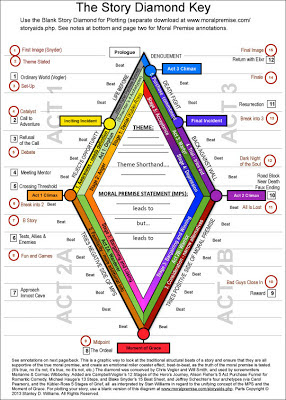On the Amazon.com Moral Premise site one reviewer asked what the Purchase Pyramid story structure was. Here's my short explanation and a couple of graphics, and below the Five Stages of Grief, a.k.a. The Kübler-Ross Model.

The "Inverse Purchase Pyramid" model of story telling is based on Allison Fisher's Purchase Funnel. It is upon this model that most romantic comedies are based. You can use this instead of the three Act model, but most effective screenplays overlay the pyramid model on top of the 3 Act model. Imagine an upside down pyramid with the widest part at the top. Divide the the pyramid into five sections with four horizontal lines. Label each area with the five stages that follow. The pyramid breaks the story into the following sequence segments: (1) AWARENESS during which the buyer needs definition of what's for sale; (2) FAMILIARITY during which the buyer needs additional information peaking interest; (3) CONSIDERATION during which the buyer narrows the alternatives for purchase; (4) TRIAL during which the buyer tries out the product; (5) PURCHASE during which the buyer commits. Now apply that to both the guy and the gal as they go through those stages of romance and you've got a winning structure. Here's an emotional roller coaster diagram of how the "5 Acts" might play out:
Five Stages of Grief
Another useful structural tool is the Kübler-Ross Model of how people typically face grief or undesirable events. In my last workshops I have a slide that lists 7 stages, but I'm going to change that back to 5, because 2 of the 7 are unlike the others. So, 5 it is. Here's a graphic that somewhat demonstrates the story algorithm. I say, "somewhat" because the ups and downs of one story dynamic to the next are never the same.
Where does this apply? Anytime you have a character going through a very difficult life change — death of someone close, divorce, loss of income, professional disappointment -- in short a grieving of any kind.
Technique: I recommend structuring your story into the 3 acts and with the help of the 13-16 turning points and sequences as described in this blog, in The Moral Premise, and in other good story technique books (e.g. Hauge, Snyder). And then, layer on the 4 Steps of Grief, if they apply. This will give you more turning points and twists in your story, hopefully positioned where the story is relatively slow. I have, as of this revised post, updated The Story Diamond Writing Aid, where you'll see the five stages overlapping with everything else. The PDF download is linked below. Click on image.

The "Inverse Purchase Pyramid" model of story telling is based on Allison Fisher's Purchase Funnel. It is upon this model that most romantic comedies are based. You can use this instead of the three Act model, but most effective screenplays overlay the pyramid model on top of the 3 Act model. Imagine an upside down pyramid with the widest part at the top. Divide the the pyramid into five sections with four horizontal lines. Label each area with the five stages that follow. The pyramid breaks the story into the following sequence segments: (1) AWARENESS during which the buyer needs definition of what's for sale; (2) FAMILIARITY during which the buyer needs additional information peaking interest; (3) CONSIDERATION during which the buyer narrows the alternatives for purchase; (4) TRIAL during which the buyer tries out the product; (5) PURCHASE during which the buyer commits. Now apply that to both the guy and the gal as they go through those stages of romance and you've got a winning structure. Here's an emotional roller coaster diagram of how the "5 Acts" might play out:
Five Stages of Grief
Another useful structural tool is the Kübler-Ross Model of how people typically face grief or undesirable events. In my last workshops I have a slide that lists 7 stages, but I'm going to change that back to 5, because 2 of the 7 are unlike the others. So, 5 it is. Here's a graphic that somewhat demonstrates the story algorithm. I say, "somewhat" because the ups and downs of one story dynamic to the next are never the same.
Where does this apply? Anytime you have a character going through a very difficult life change — death of someone close, divorce, loss of income, professional disappointment -- in short a grieving of any kind.
Technique: I recommend structuring your story into the 3 acts and with the help of the 13-16 turning points and sequences as described in this blog, in The Moral Premise, and in other good story technique books (e.g. Hauge, Snyder). And then, layer on the 4 Steps of Grief, if they apply. This will give you more turning points and twists in your story, hopefully positioned where the story is relatively slow. I have, as of this revised post, updated The Story Diamond Writing Aid, where you'll see the five stages overlapping with everything else. The PDF download is linked below. Click on image.



No comments:
Post a Comment